Power-consumption, HEXUS.bang4buck, Spider's value-for-money
Appreciating that our processor is a 125W TDP Phenom 9700 at heart, we were still interesting in taking a look at power-consumption figures for a platform as a whole. We took power measurements at the mains with the trusty watt-meter. The Intel platform will save a little power with the use of lower-power DDR3 memory but should, in theory, give it back with a power-unfriendly northbridge.
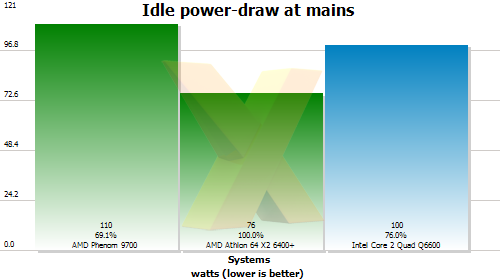
The idle measurements highlights power-draw with the system at near-zero load. All the CPUs are run with either SpeedStep or Cool'n'Quiet activated.
The quad-core competitors chew through a few more watts when idling, which is to be expected given their transistor-rich design.
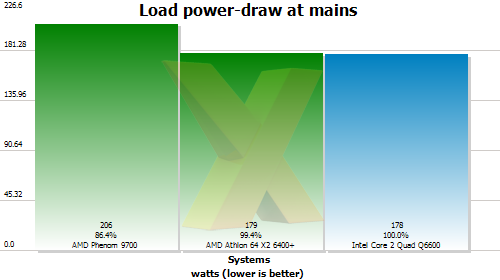
Load power-draw appears to contradict AMD's claims, with the Phenom '9700' platform consuming 28W more than the Intel's Core 2 Quad Q6600/X38, surprisingly. The one caveat resides with the engineering nature of our unreleased sample processor, which may not be indicative of processor-in-a-box models shipping in Q1 2008. We'll update this graph as soon as a retail Phenom 9600 becomes available.
HEXUS.bang4buck
Evaluating the value-for-money attractiveness of processors can be a tricky task. We're presenting three HEXUS.bang4buck graphs. The first takes a quad-core processor's worst-case scenario into account - a single-threaded application represented by our HEXUS.PiFast calculation. Our second HEXUS.bang4buck takes multi-threaded gaming into account in the form of low-resolution Quake 4. Lastly our megatasking scenario is based on the time taken to encode multi-threaded DivX whilst decoding a multi-threaded H.264 QuickTime 1080p clip. We divide the percentage-derived performance by the processors' pricing.| Benchmark | HEXUS.PiFast | Quake 4 | Megatasking | Price |
|---|---|---|---|---|
| AMD Phenom 9600 | 78.7 | 88.5 | 88.7 | £159 |
| Athlon 64 X2 6400+ | 99.8 | 95.3 | 58.6 | £115 |
| Intel Core 2 Quad Q6600 | 100 | 100 | 100 | £165 |
The numbers represent performance in the form of percentages. The winner of each benchmark is ascribed 100 per cent, and it happens to be the Intel Core 2 Quad in the three chosen metrics. We then list the other processors' performance in those benchmarks as a percentage of the leader's.
For example, the Intel Core 2 Quad Q6600 returns a time of 38.53s in our HEXUS.PiFast test. The AMD Athlon 64 X2 6400+ is only marginally slower at 38.63 seconds, or 99.8 per cent of the Intel performance. The AMD Phenom 9600 trails in last with a time of 48.64s, with that time corresponding to 78.7 per cent of the Core 2 Quad's performance. We then simply divide the percentage by the price and derive a simple HEXUS.bang4buck. Intel's will always be 0.6060 (100/165) but the others will vary in comparison. Let the graphs explain all.
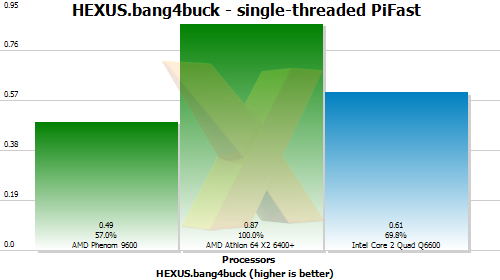
The Athlon 64 X2 6400+ wins this test by virtue of its Intel-matching performance but cheaper buy price: it as as simple as that. If the Phenom had benchmarked with exactly the same time as the Intel's its HEXUS.bang4buck would have been marginally higher due to its slightly lower price (100/159 = 0.6289). As it is, the 0.49 number is derived from 78.7/159.
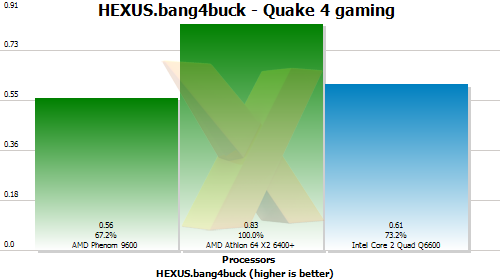
The same is largely true in Quake 4. In other words, spending an extra 40 per cent on quad-core processors is not yielding a >40 per cent gain in performance, and that's why the X2's numbers look so good.
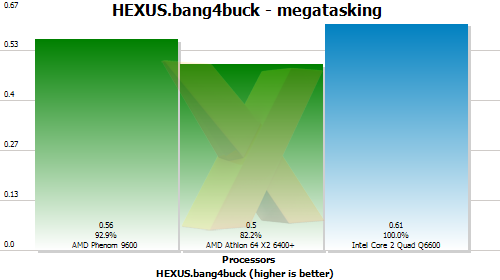
But when we head on over to megatasking, stressing the cores, the X2's cheaper price cannot compensate for the poor performance. Quad-core CPUs make sense here.
What we see is that cheaper dual-core processors do just fine until you really, really start to throw serious concurrent workload at them, and it's only then when the more expensive quad-cores begin to shine. The bottom line, though, is that Intel's Core 2 Quad Q6600 beats out the AMD Phenom 9600 in every benchmark and with respect to performance-per-pound over a variety of scenarios, albeit by only 10 per cent in some cases.
Spider thoughts
Let's do some maths and find out if the Spider platform worth it, then?With the assumption that we go with class-leading models, an AMD Phenom 9600 (£159), 790FX motherboard (£110) and Radeon HD 3870 (£145) will cost you around £415. Now, as a comparison, an Intel Core 2 Quad G0-stepping Q6600 (£165), NVIDIA 680i LT motherboard (£100) and GeForce 8800 GT 513 (£170) will cost around £435, or around £20 more.
We've established that the Intel Core 2 Quad Q6600 has the beating of the AMD Phenom 9600 - quite conviningly so in some cases. AMD's chipset and graphics card are perhaps more feature-rich than NVIDIA's 680i LT and GeForce 8800 GT but take a look at our 3870 vs. 8800 GT comparison here and you will see that NVIDIA's card offers exponentially greater performance to compensate for its additional cost. Yes, HyperTransport 3.0 and PCIe 2.0 are nice features and four-card CrossFireX is neat, but the synergy-less competition offers more performance in practically every area.
AMD's newest CPU isn't the fastest and neither is its DX10.1-toting graphics cards, so as a platform the cutting-edge interconnect don't really count for much, do they? Spider's good, sure, but you can buy faster for the same kind of money, folks. The very fact that G0-stepping Q6600s overclock like the proverbial bat out of hell doesn't hurt, either.









